
Cabell County is located in the U.S. state of West Virginia. As of the 2010 census, the population was 96,319, making it West Virginia's fourth-most populous county. Its county seat is Huntington. The county was organized in 1809 and named for William H. Cabell, the Governor of Virginia from 1805 to 1808. Cabell County is part of the Huntington-Ashland, WV-KY-OH Metropolitan Statistical Area.

Huntington is a city in Cabell and Wayne counties in the U.S. state of West Virginia. It is the county seat of Cabell County, and the largest city in the Huntington-Ashland, WV-KY-OH Metropolitan Statistical Area, sometimes referred to as the Tri-State Area. A historic and bustling city of commerce and heavy industry, Huntington has benefited from its location on the Ohio River at the mouth of the Guyandotte River. It is home to the Port of Huntington Tri-State, the second-busiest inland port in the United States.

Barboursville is a village in Cabell County, West Virginia. It is located near the second largest city in the state, Huntington. The population was 4,258 in the 2019 census estimate. Barboursville is a part of the Huntington–Ashland metropolitan area.

The Guyandotte River is a tributary of the Ohio River, approximately 166 mi (267 km) long, in southwestern West Virginia in the United States. It was named after the French term for the Wendat Native Americans. It drains an area of the unglaciated Allegheny Plateau south of the Ohio between the watersheds of the Kanawha River to the northeast and Twelvepole Creek and the Big Sandy River to the southwest. Via the Ohio River, it is part of the Mississippi River watershed.
Guyandotte is a historic neighborhood in the city of Huntington, West Virginia, that previously existed as a separate town before annexation was completed by the latter. The neighborhood is home to many historic properties, and was first settled by natives of France at the end of the eighteenth century. Guyandotte was already a thriving town when the state of West Virginia was formed from part of Virginia. Located at the confluence of the Guyandotte River and the Ohio River, it was already a regional trade center with several industries of its own when the Chesapeake and Ohio Railway (C&O) reached its western terminus nearby just across the Guyandotte River in 1873. This event was soon followed by the formation and quick development of the present city of Huntington which was named in honor of the C&O Railway's founder and then principal owner Collis P. Huntington.
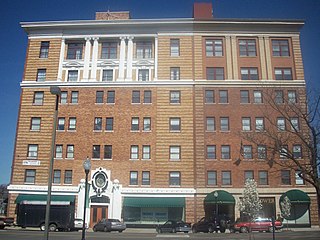
The Masonic Temple—Watts, Ritter, Wholesale Drygoods Company Building in Huntington, West Virginia, which has also been historically known as Watts, Ritter Wholesale Drygoods Company Building and more recently known as River Tower, is a commercial building. It is located at 1108 Third Avenue, in Huntington, Cabell County, West Virginia. It was built between 1914 and 1922 as a five-story brick building.
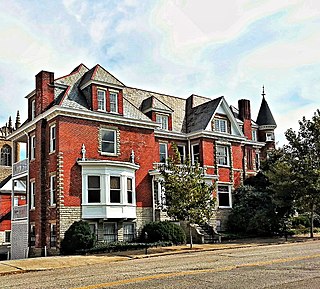
Campbell–Hicks House is a historic home located at Huntington, Cabell County, West Virginia. It was built in 1896, and is a 2+1⁄2-story, masonry dwelling in the Queen Anne style. It features a slender, two story cantilevered rounded tower. It also has a full front porch with a roof upheld by five sets of paired fluted columns with Ionic order capitals.

Harvey House, also known as the "Coin" Harvey House, is a historic home located at Huntington, Cabell County, West Virginia. It was built in 1874, and is a two-story dwelling reminiscent of houses in New Orleans. It features stained glass windows, a cast iron mantel, and a beamed ceiling in the dining room. It is most notable as the home of William Hope "Coin" Harvey.

Johnston-Meek House is a historic home located at Huntington, Cabell County, West Virginia. It is a two-story, brick Colonial Revival style dwelling with a hipped roof. The original section was built in 1832, with additions in 1838, 1923, and 1941. The 1923 Colonial Revival entrance portico and a number of other significant modifications were designed by local architect Sidney L. Day.
Kenwood, also known as the John A. Sheppard House, is a historic home located at Huntington, Cabell County, West Virginia. It was designed by the prominent West Virginia architect, H. Rus Warne, and built about 1910, and is a 2+1⁄2-story, rectangular, side gable house with flanking one-story, enclosed wings with flat roofs covered in green clay tile. The house measures approximately 100 feet long and 64 feet deep. It features an entrance portico with two story Tuscan order columns. The house is in the Classical Revival style with Greek Revival details. Also on the property is a contributing garage.
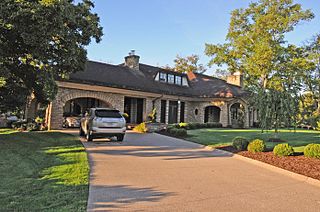
Ricketts House, also known as the Stevens Residence, is a historic home located at Huntington, Cabell County, West Virginia. It was designed in 1924, and built in 1925. It is a large stone dwelling with a complex, low pitched hipped roof punctuated by four large stone chimneys and with large overhanging eaves. The design is reflective of the Prairie School, with Tudor manor house influences. It is a significant and well-preserved work of the prominent Huntington architect, Levi J. Dean.

Zachary Taylor Wellington House is a historic home located at Huntington, Cabell County, West Virginia. It is a two-story I house form dwelling. It was originally constructed about 1847, as a small, 1+1⁄2-story, hall-and parlor house. About 1870, an addition and substantial changes were made giving the house its current appearance with Folk Victorian detailing. The house is associated with Zachary Taylor Wellington a prominent Republican politician who served in numerous public offices while residing in Guyandotte.
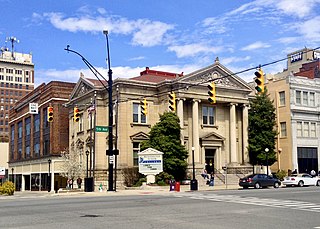
Carnegie Public Library, also known as Cabell County Public Library, is a historic library building located at Huntington, Cabell County, West Virginia. It was built in 1902–1903, in the Beaux-Arts style. It is two stories with a raised basement and has smooth gray ashlar walls. It features a pedimented, central front pavilion with paired Ionic order columns on its portico. The interior was renovated in the 1930s. It is one of 3,000 such libraries constructed between 1885 and 1919. Andrew Carnegie provided $35,000 toward the construction of the Huntington library. It served the community as a library until 1980, when a new library opened across the street. The building houses Huntington Junior College.

The Memorial Arch is a historic memorial arch located in Memorial Park at Huntington, Cabell County, West Virginia. It was built between 1924 and 1929 by the Cabell County War Memorial Association as a memorial to the dead and to those who served the county in World War I. It is built of gray Indiana limestone on a gray granite base. It measures 42 feet high, 34 feet wide, and 9 feet deep. It features Classical Revival style bas-relief carvings. The structure was rededicated in 1980. It is the only triumphal style arch in West Virginia.

Old Huntington High School is a historic high school building located at Huntington, Cabell County, West Virginia. It was built in 1916, and is a 4+1⁄2-story buff-brick building in the Classical Revival style. It consists of a long rectangle with a shorter rectangular wing on each end of the main rectangle forming a "U" shape. The courtyard is enclosed with three additions completed in 1951 (gymnasium), 1956 (cafeteria), and 1977. The building contains 155,512 square feet (14,447.5 m2) of space. The kitchen is located in an older red brick building built in 1916, built originally as a carriage house. The last graduating class was in 1996. A new facility was built to consolidate Old Huntington High and Huntington East High School into a single institution; the new school opened in August 1996 as Huntington High School. It is now known as The Renaissance Center. Part of the building was converted into apartments. The YMCA uses part of it for workout facilities and a daycare facility. The building also houses studio space, an auditorium, and small art gallery.

West Virginia Colored Children's Home, also known as the West Virginia Home for Aged and Infirm Colored Men and Women and University Heights Apartments, was a historic school, orphanage, and sanatorium building located near Huntington, Cabell County, West Virginia. It was built in 1922–1923, and was a three-story red brick building in the Classical Revival style. It was founded as the West Virginia Normal and Industrial School for Colored Children in Bluefield, West Virginia. This facility was the last of a series of buildings that were constructed to hold the state's first social institution exclusively serving the needs of African American residents. The West Virginia Colored Children's Home was closed in 1956 and the building was used as a rest home. The property transferred to Marshall University in 1961 and later it was converted to apartments. The building was demolished on May 5, 2011. The location is now an empty field.
Freeman Estate, also known as Park Hill Farm, is a historic home located at Huntington, Cabell County, West Virginia. The estate house was built between 1912 and 1914, and is a 2+1⁄2-story, masonry American Craftsman-style dwelling. It measures 11,000-square-foot (1,000 m2) and has a red, clay-tile roof. It features a front porch floored with red quarry tile, that extends approximately 80 feet (24 m) across the entire front of the home and wraps around its left side. Also on the property are a contributing stone wall and cobblestone path dated to the construction of the house.
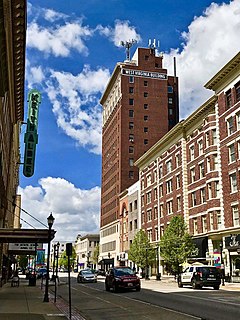
Downtown Huntington Historic District is a national historic district located at Huntington, Cabell County, West Virginia. The original district encompassed 59 contributing buildings; the boundary increase added 53 more contributing buildings. It includes the central business district of Huntington, and includes several of its municipal and governmental buildings. It contains the majority of the historic concentration of downtown commercial buildings. Notable buildings include the Huntington City Hall, Johnson Memorial Church (c.1886/1912/1935), Trinity Episcopal Church (1882), Davis Opera House, Love Hardware Building, Reuschleins Jewelry building (1923), the Newcomb Building, the Morrison Building (1919), Keith-Albee Theater (1928), West Virginia Building, and Gideon Building. Located in the district are the separately listed Carnegie Public Library, Cabell County Courthouse, U.S. Post Office and Court House, and Campbell-Hicks House.
The following is a timeline of the history of the city of Huntington, West Virginia, USA.
The Memphis Tennessee Garrison House is a historic house at 1701 10th Avenue in Huntington, West Virginia. Built about 1920, this modest two-story frame house was the home of Memphis Tennessee Garrison (1890-1988), a leading figure in the advance of African-American civil rights in Huntington, for the last forty years of her life. Garrison was a teacher, political organizer, and influential leader of the local branch of the NAACP. She was the first female of the West Virginia State Teachers Association, and vice-president of the American Teachers Association, an association of teachers working in segregated schools.


















